
- •Contents
- •Preface
- •Related Documents
- •Typographic and Syntax Conventions
- •Creating HDL Modules for CDBA Cellviews
- •Creating HDL Data as You Save CDBA Cellviews
- •Creating HDL Data from Pre-existing CDBA Cellviews
- •Quick-Start Tutorial
- •The Circuit
- •AMS Designer Tools
- •Setting Up the Tutorial
- •Running from a Script
- •Running within the AMS Environment
- •Opening the Command Interpreter Window
- •Netlisting and Compiling
- •Elaborating and Simulating the Design
- •Summary
- •Setting Up the AMS Environment
- •Overview
- •The hdl.var File
- •The ams.env Files
- •AMS Designer Supports Design Management
- •Specifying the Text Editor to Use
- •Specifying Fonts for the Cadence Hierarchy Editor
- •Preparing to Use AMS Designer from the Hierarchy Editor
- •Netlisting
- •Netlisting Modes Supported by the AMS Netlister
- •Automatic Netlisting of a Cellview
- •Netlist Updating and Netlisting of Entire Designs
- •Netlisting from the UNIX Command Line
- •Library Netlisting
- •Netlisting of Cells in Response to Changes in CDF
- •Preparing Existing Analog Primitive Libraries for Netlisting
- •Specifying the Behavior of the Netlister and Compilers
- •Opening the AMS Options Windows
- •Setting Netlister Options from the Hierarchy Editor
- •Opening the CIW AMS Options Window
- •Setting Compiler Options
- •Viewing the AMS Netlister Log
- •Understanding the Output from the AMS Netlister
- •How Inherited Connections Are Netlisted
- •Inherited Signal Connections
- •Inherited Terminal Connections
- •Instance Values for Inherited Connections
- •Third-Party Tools and Other Cadence Tools
- •How Aliased Signals Are Netlisted
- •How m-factors (Multiplicity Factors) Are Netlisted
- •How Iterated Instances Are Netlisted
- •Passing Model Names as Parameters
- •Effect of the modelname, model, and modelName Parameters
- •Handling of the model* and componentName Parameters
- •Precedence of the model* and componentName Parameters
- •Specifying Parameters to be Excluded from Netlisting
- •Ignoring Parameters for Entire Libraries
- •Example: Specifying Parameters to Ignore
- •Ensuring that Floating Point Parameters Netlist Correctly
- •Working with Schematic Designs
- •Setting Schematic Rules Checker Options for AMS Designer
- •Creating Cellviews Using the AMS Environment
- •Preparing a Library
- •Creating the Symbol View
- •Using Blocks
- •Descend Edit
- •Inherited Connections
- •Global Signals in the Schematic Editor
- •Inherited Connections in a Hierarchy
- •How Net Expressions Evaluate
- •Net and Pin Properties
- •groundSensitivity and supplySensitivity Properties
- •Making Connect Modules Sensitive to Inherited Connection Values
- •Using External Text Designs
- •Overview of Steps for Using External Text Designs
- •Bringing Modules into a Cadence Library
- •Specifying the Working Library
- •Compiling into Libraries
- •Compiling into Temporary Libraries
- •Listing Compiled Modules
- •Using Text Blocks in Schematics
- •Using Modules Located in a Cadence Library
- •Preparing for Simulation
- •Using Analog Primitives
- •Using SPICE and Spectre Netlists and Subcircuits
- •Preparing to Use SPICE and Spectre Netlists and Subcircuits
- •Placing SPICE and Spectre Netlists and Subcircuits in a Schematic
- •Using Test Fixtures
- •Creating and Using a Textual Test Fixture
- •Creating a Textual Test Fixture
- •Using a Test Fixture
- •Example: Creating and Using a Test Fixture
- •Using Design Configurations
- •Ensuring HDL Design Unit Information Is Current
- •Preparing a Design for Simulation
- •Overview of AMS Design Prep
- •What AMS Design Prep Does to Prepare a Design for Simulation
- •When to Use AMS Design Prep
- •Specifying the Behavior of AMS Design Prep
- •Setting Options for Global Design Data
- •Specifying Global Signals
- •Specifying Design Variables
- •Specifying Model Files to Use During Elaboration
- •Running AMS Design Prep
- •The cds_globals Module
- •Global Signals
- •Design Variables
- •Setting Elaborator Options
- •Setting Simulator Options
- •Setting Waveform Selection Options
- •Creating Probes
- •Selecting Instances from the Virtuoso Schematic Editing Window
- •Selecting Buses
- •Selecting Instances from the Scope Navigator
- •Copying and Pasting Within Tables
- •Elaborating and Simulating
- •Viewing Messages
- •Plotting Waveforms After Simulation Ends
- •Starting the SimVision Waveform Viewer
- •Plotting Waveforms Selected on a Schematic (Direct Plot)
- •Using the amsdesigner Command
- •Examples
- •Producing Customized Netlists
- •Producing Customized Netlists
- •Identifying the Sections of a Netlist
- •Using ams.env Variables to Customize Netlists
- •Using Netlisting Procedures to Customize Netlists
- •Examples: Problems Addressed by Customized Netlists
- •Example: Adjusting Parameter Values to Account for Number of Fingers
- •Example: Using Symbols that Represent Verilog Test Code
- •Data Objects Supported for Netlisting
- •Netlister Object
- •Formatter Object
- •Cellview Object
- •Parameter Object
- •Instance Object
- •SKILL Functions Supported for Netlisting
- •Default Netlisting Procedures
- •Netlisting Helper Functions
- •Variables for ams.env Files
- •How AMS Designer Determines the Set of Variables
- •Why AMS Designer Uses ams.env Files, Not .cdsenv Files
- •List of ams.env Variables
- •Detailed Descriptions of ams.env Variables
- •aliasInstFormat
- •allowDeviantBuses
- •allowNameCollisions
- •allowSparseBuses
- •allowUndefParams
- •amsCompMode
- •amsDefinitionViews
- •amsEligibleViewTypes
- •amsExcludeParams
- •amsExpScalingFactor
- •amsLSB_MSB
- •amsMaxErrors
- •amsScalarInstances
- •amsVerbose
- •analogControlFile
- •bindCdsAliasLib
- •bindCdsAliasView
- •cdsGlobalsLib
- •cdsGlobalsView
- •checkAndNetlist
- •checkOnly
- •checktasks
- •compileAsAMS
- •compileExcludeLibs
- •compileMode
- •connectRulesCell
- •connectRulesCell2
- •connectRulesLib
- •connectRulesView
- •detailedDisciplineRes
- •discipline
- •excludeViewNames
- •hdlVarFile
- •headerText
- •ieee1364
- •ifdefLanguageExtensions
- •incdir
- •includeFiles
- •includeInstCdfParams
- •initFile
- •instClashFormat
- •iterInstExpFormat
- •language
- •lexpragma
- •logFileAction
- •logFileName
- •macro
- •maxErrors
- •messages
- •modifyParamScope
- •ncelabAccess
- •ncelabAnnoSimtime
- •ncelabArguments
- •ncelabCoverage
- •ncelabDelayMode
- •ncelabDelayType through ncelabMessages
- •ncelabMixEsc
- •ncelabModelFilePaths
- •ncelabNeverwarn through ncelabVipdelay
- •ncsimArguments
- •ncsimEpulseNoMsg through ncsimExtassertmsg
- •ncsimGUI
- •ncsimLoadvpi through ncsimStatus
- •ncsimTcl
- •ncsimUnbuffered through ncsimUseAddArgs
- •ncvhdlArguments
- •ncvlogArguments
- •ncvlogUseAddArgs
- •netClashFormat
- •netlistAfterCdfChange
- •netlistMode
- •netlistUDFAsMacro
- •neverwarn
- •noline
- •nomempack
- •nopragmawarn
- •nostdout
- •nowarn
- •paramDefVals
- •paramGlobalDefVal
- •pragma
- •processViewNames
- •prohibitCompile
- •runNcelab
- •runNcsim
- •scaddlglblopts
- •scaddltranopts
- •scale
- •scalem
- •scannotate
- •scapprox
- •scaudit
- •sccheckstmt
- •sccmin
- •sccompatible
- •scdebug
- •scdiagnose
- •scdigits
- •scerror
- •scerrpreset
- •scfastbreak
- •scgmin
- •scgmincheck
- •schomotopy
- •sciabstol
- •scic
- •scicstmt
- •scignshorts
- •scinfo
- •scinventory
- •sclimit
- •sclteratio
- •scmacromod
- •scmaxiters
- •scmaxnotes
- •scmaxrsd
- •scmaxstep
- •scmaxwarn
- •scmethod
- •scmodelevaltype
- •scmosvres
- •scnarrate
- •scnotation
- •scnote
- •scopptcheck
- •scpivabs
- •scpivotdc
- •scpivrel
- •scquantities
- •screadic
- •screadns
- •screlref
- •screltol
- •scrforce
- •scscale
- •scscalem
- •scscftimestamp
- •scscfusefileflag
- •scskipcount
- •scskipdc
- •scskipstart
- •scskipstop
- •scspeed
- •scstats
- •scstep
- •scstop
- •scstrobedelay
- •scstrobeperiod
- •sctemp
- •sctempeffects
- •sctitle
- •sctnom
- •sctopcheck
- •sctransave
- •scusemodeleval
- •scvabstol
- •scwarn
- •scwrite
- •simRunDirLoc
- •simVisScriptFile
- •status
- •templateFile
- •templateScript
- •timescale
- •update
- •use5xForVHDL
- •useDefparam
- •useNcelabNowarn
- •useNcelabSdfCmdFile
- •useNcsimNowarn
- •useNowarn
- •useScaddlglblopts
- •useScaddltranopts
- •useScic
- •useScreadic
- •useScreadns
- •useScwrite
- •useSimVisScriptFile
- •useProcessViewNamesOnly
- •verboseUpdate
- •vlogGroundSigs
- •vloglinedebug
- •vlogSupply0Sigs
- •vlogSupply1Sigs
- •wfDefaultDatabase
- •wfDefInstCSaveAll
- •wfDefInstCSaveLvl
- •wfDefInstSaveCurrents
- •wfDefInstSaveVoltages
- •wfDefInstVSaveAll
- •wfDefInstVSaveLvl
- •wfDefInstVSaveObjects
- •Updating Legacy SimInfo for Analog Primitives
- •The ams Fields
- •Special Handling of model, modelName, modelname, and componentName
- •Converting an Existing Analog Primitive Library
- •Designing for Virtuoso AMS Compliance
- •Terminals
- •Buses
- •Component Description Format
- •Parameters
- •Using Inherited Parameters
- •Using Cell Parameters
- •Parameterized Cells
- •VHDL-AMS Component Declarations
- •Properties
- •Properties to Avoid Completely
- •Avoid the portOrder Property Unless Required by Special Circumstances
- •Properties to Use Only in AMS Compatibility Mode
- •Properties That Have No Special Meaning in the AMS Environment
- •Properties Fully Supported by the AMS Environment
- •SKILL Functions
- •amsCheckCV
- •amsIsPresent
- •amsNetlist
- •amsProcessCellViews
- •amsUIOptionsForm
- •amsUIRunNetlisterForm
- •ddsCvtAMSTranslateCell
- •ddsCvtAMSTranslateLib
- •ddsCvtToolBoxAMS
- •vmsUpdateCellViews
- •Customization Variables
- •schHdlNotCreateDB
- •schHdlUseVamsForVerilog
- •vmsAnalysisType
- •vmsCreateMissingMasters
- •vmsNcvlogExecutable
- •vmsPortProcessing
- •vmsRunningInUI
- •vmsTemplateScript
- •vmsVerboseMsgLevel
- •Compiling Cadence-Provided Libraries
- •Purpose of the amsLibCompile Tool
- •Running the amsLibCompile Tool Manually
- •Example

Virtuoso AMS Environment User Guide
Netlisting
If you do not specify a view, the AMS netlister operates on each view type specified by the amsEligibleViewTypes variable in the ams.env file. (The views operated on can be further tuned by specifying view names to process or exclude. For more information, see “Setting View Selection Options” on page 90.)
5.Select what you want the AMS netlister to do with the specified cellviews in the current run. Choose incremental netlisting if you want to netlist only new or changed cellviews.
Note that changes you make here are for this run only and do not affect the settings in the Options menu.
6.Click OK to begin the run.
Netlisting of Cells in Response to Changes in CDF
In this method, the AMS netlister runs when you use the CDF editor to update the CDF information for a cell (provided that the netlistAfterCdfChange variable in the ams.env file is set tot). The amsEligibleViewTypes variable in the ams.env file specifies which cellviews of the cell are eligible for netlisting.
For more information, see “netlistAfterCdfChange” on page 454 and“amsEligibleViewTypes” on page 380.
Preparing Existing Analog Primitive Libraries for Netlisting
Cadence netlisters format instances of analog devices according to the instructions specified in the Simulation Information (simInfo) section of the device’s CDF. The simInfo is composed of one or more sets of directions, parameters, and terminal names, with each set representing the formatting instructions for that device for a given simulator. To support the AMS simulator, the simInfo for analog primitives now contains a new section called ams.
Cadence provides a conversion tool that helps you generate the new ams simInfo from the corresponding spectre information. For more information, see Appendix B, “Updating Legacy SimInfo for Analog Primitives.”
Specifying the Behavior of the Netlister and Compilers
By default, the behavior of the AMS netlister and compilers is controlled by variables stored in files namedams.env. These variables tell the netlister and compilers what they should do in general (for example, check the design or check and netlist the design) and what to do in certain situations (if the netlister encounters sparse buses or conflicting bus ranges).
April 2004 |
74 |
Product Version 5.3 |

Virtuoso AMS Environment User Guide
Netlisting
See Appendix A, “Variables for ams.env Files,” for detailed descriptions of the variables.
Opening the AMS Options Windows
There are two main graphical interfaces that you can use to set the ams.env values:
■Through AMS – Options in the Cadence hierarchy editor
For guidance on using this interface, see “Opening the Hierarchy Editor AMS Options Window” on page 75.
■Through Tools – AMS – Options in the CIW
For guidance on using this interface, see “Opening the CIW AMS Options Window” on page 86.
You can set the values of most variables using either of these interfaces. They both operate on the same ams.env file so changes that you make from one interface are reflected in the other. However, variables that control what happens when you check and save from a schematic, and variables that specify the views that are eligible for netlisting are available only in the CIW interface.
Opening the Hierarchy Editor AMS Options Window
To review or change the current options from the Cadence hierarchy editor,
1.Start the hierarchy editor, install the AMS menu item, and select a run directory.
For guidance, see “Preparing to Use AMS Designer from the Hierarchy Editor” on page 62.
2.Choose AMS – Options and then one of the subchoices.
April 2004 |
75 |
Product Version 5.3 |
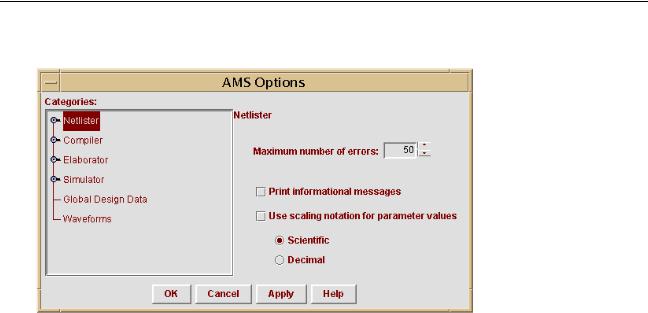
Virtuoso AMS Environment User Guide
Netlisting
The AMS Options window appears.
The Categories pane of the window shows the options categories: Netlister, Compiler,
Elaborator, Simulator, Global Design Data, and Waveforms.
For guidance on setting these options
Netlister
See
“Setting Netlister Options from the Hierarchy Editor” on page 77
Compiler |
“Setting Compiler Options” on page 98 |
|
Elaborator |
“Setting Elaborator Options” on page 232 |
|
Simulator |
“Setting Simulator Options” on page 247 |
|
Global Design Data |
“Setting Optionsorf Global Design Data” on page 211 |
|
|
|
|
|
Because the Global Design Data options affect |
|
|
AMS Design Prep, rather than the AMS netlister, there |
|
|
is no corresponding graphical interface available from |
|
|
the CIW. |
|
Waveforms |
“Setting Waveform Selection Options” on page 274 |
|
Note that if you click OK or Apply after selecting settings in the AMS Options window, the revised options are immediately saved to the AMS environment file,ams.env, and become the default values. If you edit the ams.env file outside of the Cadence hierarchy editor, the edited settings appear in the AMS Options window the next time AMS reads the ams.env file.
April 2004 |
76 |
Product Version 5.3 |

Virtuoso AMS Environment User Guide
Netlisting
Setting Netlister Options from the Hierarchy Editor
The netlister options available from the hierarchy editor interface are organized in the following categories:
Category |
Purpose |
For information, see |
|
Netlister |
Controls general netlister |
“Setting General Netlister Options” |
|
|
options |
on page 77 |
|
Verilog-AMS |
Controls how language |
“Setting erilogV-AMS Options for |
|
|
extensions are handled |
the Netlister” on page 79 |
|
CDF |
Specifies default values for “Specifying Default Values for CDF |
||
Parameter |
CDF parameters |
Parameters” on page 80 |
|
Defaults |
|
|
|
Template |
Controls what information |
“SettingemplateT Header and File |
|
|
and files are included in |
Include Options” on page 81 |
|
|
netlist templates |
|
|
Compatibility |
Controls options that allow |
“Setting Compatibility Options” on |
|
|
you to retain data |
page 84 |
|
|
compatibility with older |
|
|
|
netlisters, such as the |
|
|
|
Cadence analog design |
|
|
|
environment or Verilog |
|
|
|
Integ |
|
|
Setting General Netlister Options
With the options in this category, you can set the maximum number of error messages displayed in the log file when you netlist, and you can specify the kind of scaling to be used for parameter values.
To display the Netlister pane,
April 2004 |
77 |
Product Version 5.3 |
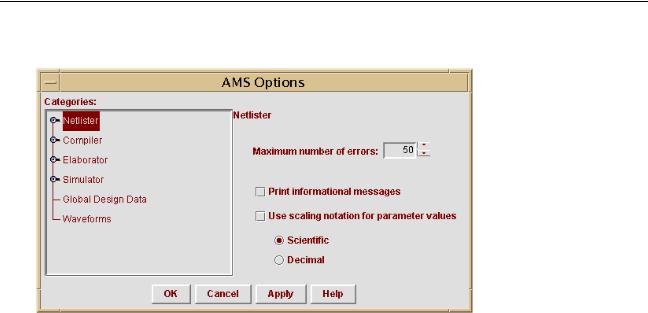
Virtuoso AMS Environment User Guide
Netlisting
Select the Netlister category.
Setting the Maximum Number of Displayed Error Messages
To set the maximum number of displayed error messages,
Click and type in the Maximum number of errors field or use the up and down arrow keys to set the maximum number of errors the AMS netlister can encounter before it stops processing the design.
For information on the corresponding ams.env variable, see “amsMaxErrors” on page 385.
Note: If any errors are found, no netlist is generated and any existing netlist is removed. This behavior ensures that you do not inadvertently simulate an out-of-date netlist.
Requesting More Numerous and More Extensive Messages
To increase the amount of information produced as messages, as you might want to do when you are debugging a problem,
Select the Print informational messages option.
For information on the corresponding ams.env variable, see “amsVerbose” on page 387.
Setting the Scaling Notation for Parameter Values
You can control the netlisting of scaling factors for parameter values by expanding the scaling factors as desired. To expand scaling factor suffixes,
April 2004 |
78 |
Product Version 5.3 |
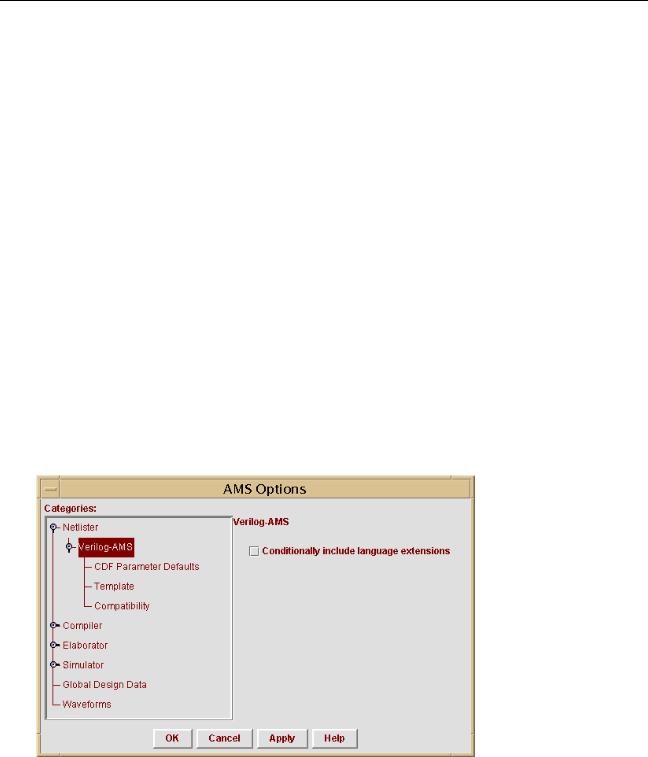
Virtuoso AMS Environment User Guide
Netlisting
1.Select the Use scaling notation for parameter values option.
2.Set the scaling notation that you want to use for parameter values,
Select Scientific to expand scaling factor suffixes in scientific notation.
For example, this choice expands 5.46M as 5.46e6.
Select Decimal to expand scaling factor suffixes in decimal notation.
For example, this choice expands 5.46M as 5,460,000.
For information on the corresponding ams.env variable and a list of scaling factor suffixes supported by various target simulators, see “amsExpScalingFactor” on page 382.
Setting Verilog-AMS Options for the Netlister
This pane allows you to set an option that can make AMS Designer netlists compatible with simulators that cannot handle AMS language extensions. The AMS Designer netlister enables this capability by enclosing language extensions in conditional statements. With these conditional statements in place, you can control when language extensions are active.
To set options for language extensions,
1. Select the Netlister – Verilog-AMS category to display the Verilog-AMS pane.
2.Select the Conditionally include language extensions option if you want extended language constructs to be conditionally included.
April 2004 |
79 |
Product Version 5.3 |
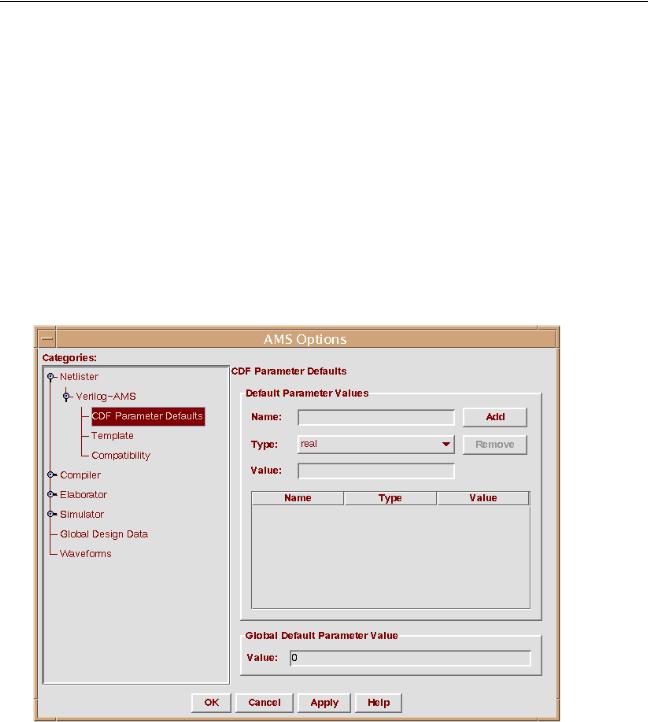
Virtuoso AMS Environment User Guide
Netlisting
If you select this option, the netlister sets off language extensions with `ifdef INCA directives, which facilitates using the netlist in simulators that do not support the extensions.
For information on the corresponding ams.env variable, see “ifdefLanguageExtensions” on page 410.
Specifying Default Values for CDF Parameters
With the options in this category, you can specify default values for CDF parameters.
To display the CDF Parameter Defaults pane,
Select the Netlister – Verilog-AMS – CDF Parameter Defaults category to display the CDF Parameter Defaults pane.
Specifying Default Values for Specific CDF Parameters
To specify a default value for a specific CDF parameter,
1. Type the name of the parameter in the Name field.
April 2004 |
80 |
Product Version 5.3 |

Virtuoso AMS Environment User Guide
Netlisting
2.In the Type field, selectinteger or real to indicate the type of the parameter.
3.Type a default value into the Value field.
4.Click Add.
The newly specified default value appears in the list below.
The AMS netlister uses this default value when the specified parameter does not have a default value in the CDBA data.
For information on the corresponding ams.env variable, see “paramDefVals” on page 464.
To remove the default value for a parameter,
Select the parameter in the list and then click Remove.
Specifying a Global Default Value for CDF Parameters
To specify a global default parameter value,
Type a default value into the Value field of theGlobal Default Parameter Value section.
The AMS netlister uses this default value for any parameter in the CDBA data that does not otherwise have a default value.
For information on the corresponding ams.env variable, see “paramGlobalDefVal” on page 465.
Setting Template Header and File Include Options
With the options in this category, you can specify headers for AMS netlists and you can specify the names of files to be included by‘include directives.
To display the Template pane,
April 2004 |
81 |
Product Version 5.3 |

Virtuoso AMS Environment User Guide
Netlisting
Select the Netlister – Verilog-AMS – Template category to display the Template pane.
Specifying the Header to be Used in AMS Netlists
To specify the header to be used in AMS netlists,
1.In the Template Header area, select the method you want to use to specify template headers.
For information on the corresponding ams.env variable, see “headerTxt” on page 408
Default
April 2004 |
82 |
Product Version 5.3 |

Virtuoso AMS Environment User Guide
Netlisting
Inserts the default header at the top of each generated netlist.
For example, choosing Default inserts the following text into netlists.
//Verilog-AMS netlist generated by the AMS netlister, version 4.4.6.100.43.
//Cadence Design Systems, Inc.
Include the text from this file
Inserts the default header and the contents of the specified file at the top of each generated netlist.
For example, choosing Include the text from this file and specifying a file containing the following text
//Module produced by
//ASIC Team: Ocelot
//San Jose Development Center
inserts the following at the top of each generated netlist.
//Verilog-AMS netlist generated by the AMS netlister, version 4.4.6.100.43.
//Cadence Design Systems, Inc.
//Module produced by
//ASIC Team: Ocelot
//San Jose Development Center
Include the output of this script
Inserts the default header and the results of running the specified script at the top of each generated netlist.
For example, Choosing Include the output of this script and specifying a file containing the following script
echo ’// Module produced by:’ echo ’// ASIC Interactive, Ltd.’ printf ’// (c) ’
date ’+DATE: %m/%d/%y%n’
inserts the following at the top of each generated netlist.
//Verilog-AMS netlist generated by the AMS netlister, version 4.4.6.100.43.
//Cadence Design Systems, Inc.
//Module produced by:
//ASIC Interactive, Ltd.
//(c) DATE: 10/10/01
2.If you select either of the latter two choices in the previous step, specify the path and filename of the text file or script file.
Relative paths are resolved with respect to the directory where you started the AMS software.
April 2004 |
83 |
Product Version 5.3 |

Virtuoso AMS Environment User Guide
Netlisting
For information on the corresponding ams.env variables, see “headerTxt” on page 408, “templateFile” on page 551, and“templateScript” on page 552.
Specifying Files to be Included in AMS Netlists
To specify files to include in the netlist by‘include directives,
1.Type the name of the file to include in theFilename field.
The name that you enter appears verbatim in the netlist.
For information on the corresponding ams.env variable, see “includeFiles” on page 412.
2.Click Add to add the filename to the list of filenames displayed below theFilename field.
The newly added file is included, with a‘include directive, in every netlist. To control which file of that name is included, you can use theInclude Directory table accessed by choosing Compiler – Verilog-AMS – Macros/Includes in the AMS Options window. For guidance, see “Specifying Macros and Specifying Directories to be Searched” on page 104.
3.To remove a file from the list, select the filename, and then clickRemove.
4.If necessary, move a filename up or down in the list by clicking the up and down arrows.
Files are included in the netlist in the order that they appear in the list. The order is important if you have files that use declarations in another file. For example,File2if
uses a declaration from File1, you must ensure that File1 is above File2 in the list.
Setting Compatibility Options
If you have the following design exceptions in your cellview, the AMS netlister, by default, either issues a warning or does not create a netlist.
Exception |
For an explanation of the exception and a description of the |
|
corresponding ams.env variable, see |
||
|
||
Illegal identifiers |
“allowIllegalIdentifiers” on page 370 |
|
Name collisions |
“allowNameCollisions” on page 372 |
|
Conflicting bus ranges |
“allowDeviantBuses” on page 368 |
|
Sparse buses |
“allowSparseBuses” on page 374 |
To override this default behavior,
April 2004 |
84 |
Product Version 5.3 |
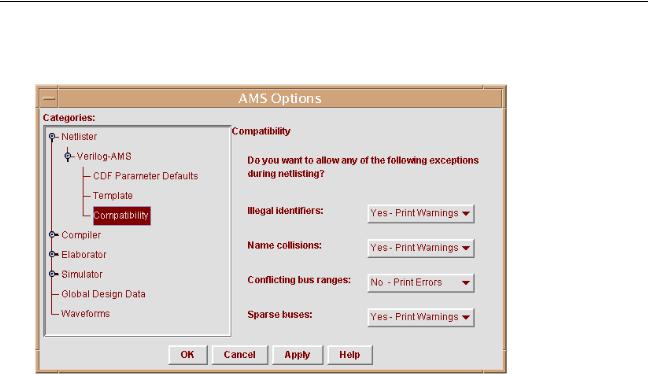
Virtuoso AMS Environment User Guide
Netlisting
1.Select the Netlister – Verilog-AMS – Compatibility category to display the
Compatibility pane.
2.Select the settings you want for each of the exceptions. Each exception has the following possible settings:
No – Print Errors: The AMS netlister issues an error if the netlister encounters the design exception. No netlist is produced.
Yes – Print Warnings: The AMS netlister issues a warning if the netlister encounters the design exception. Netlisting continues after the netlister makes necessary changes.
Yes – Silently: The AMS netlister continues netlisting if it encounters the design exception, after making changes that allow netlisting to continue. The AMS netlister does not issue a warning.
If you select Yes – Print Warnings or Yes – Silently, the AMS netlister makes the following changes when it encounters a design exception.
Illegal identifiers: Maps non-compliant identifiers to names that are legal in the target language. The associated warning, if issued, tells you how the name is mapped.
Name collisions: Maps non-compliant names to system-generated names that are legal in the target language.
Conflicting bus ranges: Netlisting continues if it is possible to create a valid netlist.
The generated netlist is likely to be less readable than one created from compliant
April 2004 |
85 |
Product Version 5.3 |
